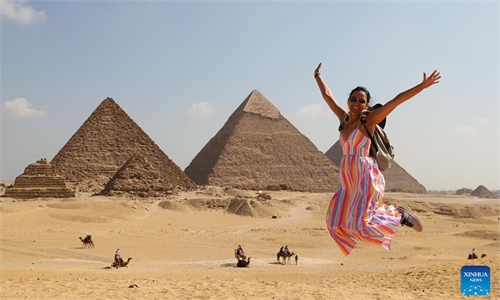ARTS / CULTURE & LEISURE
Exhibition in China sparks passion for Egyptian culture, shows affinity between ancient civilizations
Winds of the Nile blow across the Yangtze
It has been a week since the exhibition On Top of the Pyramid: The Civilization of Ancient Egypt kicked off at the Shanghai Museum on July 19. The response has been overwhelming. Despite the scorching summer heat, there has been a constant long line of visitors queuing up in front of the museum, or at the entrance of the exhibition's shop. Tickets for the summer vacation season sold out long ago, and even the extra-added night tickets were quickly snapped up.

It comes as no surprise to me, that the historical and cultural treasures of remote Egypt have been so warmly embraced by Chinese people. When I was visiting the exhibition, I was surprised by its extremely high standards and quality. I was told that, among the 788 exhibits from different periods of ancient Egypt, over 95 percent are being displayed in Asia for the first time. From statues of pharaohs and anthropoid inner coffins to gold jewelry, these carefully curated and beautifully presented artifacts can transport Chinese visitors back to the mysterious and charming Egypt of ancient times.
The Shanghai Museum is renowned for its expertise in selecting high-quality exhibition pieces. "Egypt Nanxi" is the screen name of an Egyptian vlogger who is popular on Chinese social media for spreading Egyptian culture. In her latest video, Egypt Nanxi, dressed as an ancient Egyptian goddess or nobility, visits the exhibition and introduces some highlighted handicrafts on display.
Except for the treasures of Tutankhamun, which are prohibited from leaving Egypt, the exhibition includes representative works from several major Egyptian archaeological finds, says Egypt Nanxi in the video, which had earned more than 1.2 million views as of Thursday.
"The Shanghai Museum is very skilled at selecting artifacts. It does not simply choose based on delicacy, but rather places more value on the historical significance and representativeness behind each piece," praises the vlogger. "The exhibition is so popular [in China]. As an Egyptian, I feel very proud," she says with a smile.
My net friend Shrehan Abd Elhamid, an Egyptian culture vlogger who also teaches Chinese language and archaeology, said she was very glad to see the exhibition and Egyptian culture become popular in China.
"This form of cross-cultural exchange is very valuable and able to enhance the mutual friendship and respect," she told me in fluent Putonghua. "This is not only a cultural exchange, but also a spiritual resonance between the two peoples."
Apart from the high quality of exhibits, another main reason that the exhibition is drawing such immense popularity is that Chinese people naturally feel a sense of affinity and closeness to Egypt, as its civilization is as ancient as their own.
In "The Land of the Pharaohs" hall, a main section of the exhibition that tells "a condensed history of ancient Egyptian civilization," I saw not only numerous exquisite ancient Egyptian exhibits, but also a few ancient Chinese artifacts that wonderfully have a lot in common with the Egyptian relics in terms of shape, design or usage.
"We selected some Chinese exhibits to be part of the exhibition, in the hope that visitors can closely look at the mutual learning between civilizations through the vivid 'dialogue' between the cultural relics of the two countries," said the museum's director Chu Xiaobo.
I also talked to the exhibition's Egyptian co-curator Raafat Genady, who said he would stay in Shanghai for 20 days for the exhibition. Genady mentioned the similarities between the ancient Egyptian and Chinese civilizations, saying that there may have been a lot of communication, exchanges and trading between the two countries from a long time ago.
"[The exhibits shows the] integration between civilizations," he said.
The ongoing exhibition in Shanghai is the first time the world's two oldest civilizations have had official cultural exchanges in the form of an exhibition. China and Egypt have also taken joint actions in the preservation of cultural heritage, such as the joint application for UNESCO World Heritage status for China's Baiheliang inscriptions and Egypt's Nilometer.
I believe that as the two countries further deepen cooperation in this field, China and Egypt will become a model for the exchanges of ancient civilizations. With the increasing popularity of the current exhibition in Shanghai, the winds of the Nile are blowing across the lower reaches of the Yangtze River, anticipating the writing of a new chapter in the mutual learning between the Chinese and Egyptian civilizations.
The author is a reporter with the Global Times. life@globaltimes.com.cn

Illustration: Liu Xiangya/GT
Having been to the exhibition in person, I vividly experienced an atmosphere buzzing with excitement, anticipation and curiosity, as many people around eagerly awaited their turn to step into the mystical world of pharaohs and pyramids.It comes as no surprise to me, that the historical and cultural treasures of remote Egypt have been so warmly embraced by Chinese people. When I was visiting the exhibition, I was surprised by its extremely high standards and quality. I was told that, among the 788 exhibits from different periods of ancient Egypt, over 95 percent are being displayed in Asia for the first time. From statues of pharaohs and anthropoid inner coffins to gold jewelry, these carefully curated and beautifully presented artifacts can transport Chinese visitors back to the mysterious and charming Egypt of ancient times.
The Shanghai Museum is renowned for its expertise in selecting high-quality exhibition pieces. "Egypt Nanxi" is the screen name of an Egyptian vlogger who is popular on Chinese social media for spreading Egyptian culture. In her latest video, Egypt Nanxi, dressed as an ancient Egyptian goddess or nobility, visits the exhibition and introduces some highlighted handicrafts on display.
Except for the treasures of Tutankhamun, which are prohibited from leaving Egypt, the exhibition includes representative works from several major Egyptian archaeological finds, says Egypt Nanxi in the video, which had earned more than 1.2 million views as of Thursday.
"The Shanghai Museum is very skilled at selecting artifacts. It does not simply choose based on delicacy, but rather places more value on the historical significance and representativeness behind each piece," praises the vlogger. "The exhibition is so popular [in China]. As an Egyptian, I feel very proud," she says with a smile.
My net friend Shrehan Abd Elhamid, an Egyptian culture vlogger who also teaches Chinese language and archaeology, said she was very glad to see the exhibition and Egyptian culture become popular in China.
"This form of cross-cultural exchange is very valuable and able to enhance the mutual friendship and respect," she told me in fluent Putonghua. "This is not only a cultural exchange, but also a spiritual resonance between the two peoples."
Apart from the high quality of exhibits, another main reason that the exhibition is drawing such immense popularity is that Chinese people naturally feel a sense of affinity and closeness to Egypt, as its civilization is as ancient as their own.
In "The Land of the Pharaohs" hall, a main section of the exhibition that tells "a condensed history of ancient Egyptian civilization," I saw not only numerous exquisite ancient Egyptian exhibits, but also a few ancient Chinese artifacts that wonderfully have a lot in common with the Egyptian relics in terms of shape, design or usage.
"We selected some Chinese exhibits to be part of the exhibition, in the hope that visitors can closely look at the mutual learning between civilizations through the vivid 'dialogue' between the cultural relics of the two countries," said the museum's director Chu Xiaobo.
I also talked to the exhibition's Egyptian co-curator Raafat Genady, who said he would stay in Shanghai for 20 days for the exhibition. Genady mentioned the similarities between the ancient Egyptian and Chinese civilizations, saying that there may have been a lot of communication, exchanges and trading between the two countries from a long time ago.
"[The exhibits shows the] integration between civilizations," he said.
The ongoing exhibition in Shanghai is the first time the world's two oldest civilizations have had official cultural exchanges in the form of an exhibition. China and Egypt have also taken joint actions in the preservation of cultural heritage, such as the joint application for UNESCO World Heritage status for China's Baiheliang inscriptions and Egypt's Nilometer.
I believe that as the two countries further deepen cooperation in this field, China and Egypt will become a model for the exchanges of ancient civilizations. With the increasing popularity of the current exhibition in Shanghai, the winds of the Nile are blowing across the lower reaches of the Yangtze River, anticipating the writing of a new chapter in the mutual learning between the Chinese and Egyptian civilizations.
The author is a reporter with the Global Times. life@globaltimes.com.cn




